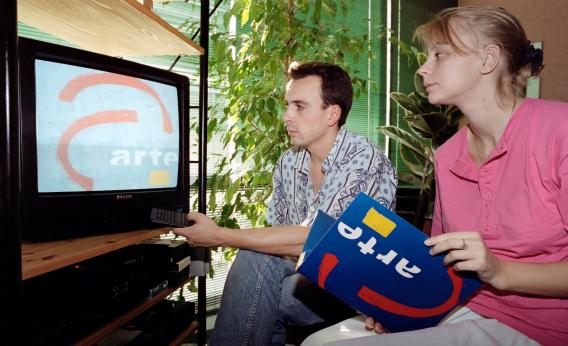You’ll Love This Kids’ TV Show (Even if You Don’t Understand It)

Photo by Frederic Florin/AFP/GettyImages.
Learning a foreign language as an adult is an undignified experience. You can only manage mind-numbing conversation: Time to count! Now to shop! Praise the beer, es ist so gut! You’re repaid for enormous effort with a nagging sense of idiocy: For a long while, you can barely say or understand anything. Watching TV in this context is a bad idea.
Imagine my relief, then, flipping on a German TV to Karambolage—a beautifully animated kids’ show exploring cross-cultural quiddities in everyday life—oddities that puzzled me, an ex-pat from New York living in Berlin, daily. The show is funny and brimming with insights, it shrugs off miscommunications, and—crucially—it animates every line of its text in pictures, so you don’t need to understand the words to get the point.
I’d been wondering: What are those odd devices in my German kitchen drawer? Karambolage showed me how my Eierpieker punctures eggs before boiling so they don’t burst and my Bierwärmer brings chilled beer to the optimal drinking temperature. How does this double-headed Berliner key work? It slips through the lock after opening the door! Why do French people tuck their sheets in before falling asleep? (Something about minimizing drafts.) Karambolage even demystifies curious sights you barely noticed before, like Turks ritually bathing their faces in sunshine. (It’s a Kurdish observance at sunrise or sunset, asking for blessings on one’s family and friends.)
Karambolage—the name means “collision”—appears on Sunday evenings on ARTE, a French-German arts and culture channel. Each 12-minute episode plumbs culture clashes, either between the historically quarrelsome Germans and French or from within each country’s respective immigrant populations, with short vignettes that focus on a particular object, etymology, or ritual—say, an Algerian woman grinding a soft alumstone with musk oil and applying it as deodorant. Its “onomatopoeia” segment surveys German and French ways of making a sound, from champagne corks to bees to saying someone is crazy. (The French tap their foreheads and say “tuck-tuck” or “za-za” while Germans shake an open hand over their face and say “plem-plem”.) Each show closes with a puzzle, a street scene shot in either France or Germany; one clue gives the location away.
I am besotted with Karambolage. It’s hands-down excellent TV on multiple levels: if you think kids deserve clever, beautiful television, check. If you want to buff your own German or French into shape, another check. If you just want to revel in smart, good-looking animation, a big fat check. I owe my now-fluent German partly to watching Karambolage, but the truth is: You don’t need to fully understand it to love it.
If you are a struggling conversationalist auf Deutsch (or en français), Karambolage offers ideal practice for listening skills, replete with broad hints. Take this segment on how the “Cordon Bleu” sandwich got its name. (It dates to 1578, when Henri III’s Ordre du saint Ésprit made blue ribbons synonymous with excellence):
This segment explains how bunnies and eggs became Easter symbols and also recaps the French legend, which is that church-bells travel to Rome and return on Easter Sunday full of eggs for children. (Skip to 2:37.)
Tune into Karambolage online—they post new episodes every Monday. All nerdy indulgences—and language homework assignments—should taste so verdammt good.
